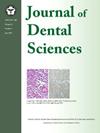The mesial–mesial/distal–distal (MM-DD) occlusal adjustment technique: A 2–21.5-year retrospective study on preventing open contacts in posterior implant restorations
IF 3.1
3区 医学
Q1 DENTISTRY, ORAL SURGERY & MEDICINE
引用次数: 0
Abstract
Background/purpose
Open contacts adjacent to posterior dental implants are a common clinical complication, often resulting in food impaction, discomfort, and periodontal deterioration. This study aimed to evaluate the long-term clinical effectiveness of the mesial–mesial/distal–distal (MM-DD) occlusal adjustment technique in preventing open contacts adjacent to posterior implant restorations.
Materials and methods
This retrospective study analyzed 124 single-tooth posterior implants in 100 patients over a 2–21.5-year follow-up period. The MM-DD technique involved selectively modifying occlusal contacts on the mesial occlusal surface of the mesial adjacent tooth and the distal occlusal surface of the distal adjacent tooth to influence mesial tooth movement and maintain proximal contact with implant restorations. Clinical and radiographic data were assessed for contact integrity, food impaction, discomfort, bone levels, and other outcomes. A control group with conventional occlusal adjustment was included for comparison.
Results
The MM-DD group demonstrated a significantly lower incidence of open contacts (2.7 %) compared to the control group (46.7 %, P <0.001). Patients treated with the MM-DD technique reported reduced food impaction and lower discomfort scores, with less proximal bone loss around adjacent teeth. Kaplan–Meier analysis showed high rates of long-term contact stability in the MM-DD group, with 96.2 % of contacts remaining intact at 15 years.
Conclusion
With its straightforward application, sound biological foundation, and minimal need for specialized equipment, the MM-DD technique presents a practical and effective solution for preserving proximal contact in posterior implants and is well-suited for widespread adoption in daily dental practice.
中-中/远-远(MM-DD)咬合调节技术:一项2 - 21.5年的预防后牙种植体修复开放接触的回顾性研究
背景/目的与后牙种植体相邻的开放接触是常见的临床并发症,常导致食物嵌塞、不适和牙周恶化。本研究旨在评估中-中/远-远侧(MM-DD)咬合调整技术在防止与后牙体修复体相邻的开放接触中的长期临床效果。材料与方法回顾性分析100例患者124颗单牙后牙种植体,随访2 ~ 21.5年。MM-DD技术涉及选择性地改变近中邻牙近中咬合面和远中邻牙远端咬合面咬合接触,以影响近中牙的运动并保持近端与种植体修复体的接触。临床和影像学资料评估接触完整性、食物嵌塞、不适、骨水平和其他结果。对照组采用常规咬合调整方法进行比较。结果MM-DD组开放性接触发生率(2.7%)明显低于对照组(46.7%,P <0.001)。接受MM-DD技术治疗的患者报告食物嵌塞减少,不适评分较低,邻牙周围近端骨质流失较少。Kaplan-Meier分析显示,MM-DD组的长期接触稳定性较高,96.2%的接触在15年内保持完整。结论MM-DD技术应用简单,生物基础良好,对专用设备需求少,是一种实用有效的后牙种植体近端接触保存方法,适合在日常牙科实践中广泛应用。
本文章由计算机程序翻译,如有差异,请以英文原文为准。
求助全文
约1分钟内获得全文
求助全文
来源期刊

Journal of Dental Sciences
医学-牙科与口腔外科
CiteScore
5.10
自引率
14.30%
发文量
348
审稿时长
6 days
期刊介绍:
he Journal of Dental Sciences (JDS), published quarterly, is the official and open access publication of the Association for Dental Sciences of the Republic of China (ADS-ROC). The precedent journal of the JDS is the Chinese Dental Journal (CDJ) which had already been covered by MEDLINE in 1988. As the CDJ continued to prove its importance in the region, the ADS-ROC decided to move to the international community by publishing an English journal. Hence, the birth of the JDS in 2006. The JDS is indexed in the SCI Expanded since 2008. It is also indexed in Scopus, and EMCare, ScienceDirect, SIIC Data Bases.
The topics covered by the JDS include all fields of basic and clinical dentistry. Some manuscripts focusing on the study of certain endemic diseases such as dental caries and periodontal diseases in particular regions of any country as well as oral pre-cancers, oral cancers, and oral submucous fibrosis related to betel nut chewing habit are also considered for publication. Besides, the JDS also publishes articles about the efficacy of a new treatment modality on oral verrucous hyperplasia or early oral squamous cell carcinoma.
 求助内容:
求助内容: 应助结果提醒方式:
应助结果提醒方式:


